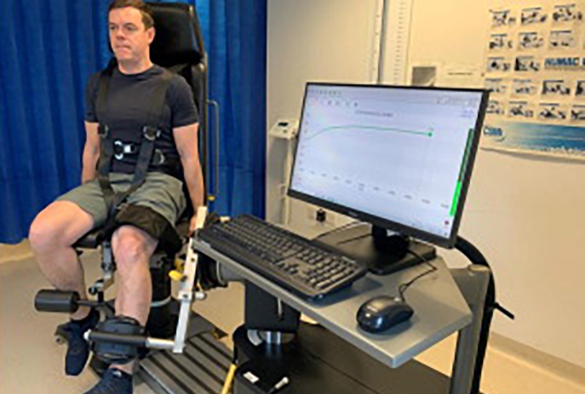Study finds affordable alternative to ACL injury testing

New ILCaMS research highlights how a more affordable and effective method of judging the success of Anterior Cruciate Ligament (ACL) surgery could reduce the risk of recurring injury.
ACL injury is common, particularly among athletes and those with physically demanding occupations, with over 30,000 ACL reconstruction surgeries being carried out in England every year.
The rehabilitation process for ACL reconstruction surgery can be both lengthy and painful. Following surgery, recovery of strength in the quadriceps (the large muscle at the front of the thigh) is an important assessment that informs clinical decision making including return to running and return to play.
The current ‘gold standard’ for quadriceps strength testing is Electromechanical Dynamometry, a procedure costing upwards of £50,000 and usually only available to professional athletes. For the general population, the widely-used and more affordable 'Push-type' handheld dynamometry (HHD) has drawbacks, underestimating quadriceps strength by nearly 30%.
Dr Rachel Oldershaw from the Department of Musculoskeletal and Ageing Science worked in partnership with Richard Norris at Aintree University Hospital to explore alternative testing methods in the hope of providing an accessible and reliable method of testing joints post-surgery.
The study trialled a technique called Inline Dynamometry, which can be carried out using portable and readily available equipment at a cost of less than £800, to test the quadriceps strength in 50 healthy and 52 ACL-reconstructed patients. The results showed that Inline Dynamometry provided reliable measurements of quadriceps strength in both sets of participants.
Dr Oldershaw said: “Inline Dynamometry offers clinicians a practical means of testing quadriceps strength and will hopefully be integrated into general practice, as an objective measure, to guide rehabilitation and improve patient outcomes following ACL reconstruction.
“Where electromechanical dynamometry is not available, clinicians now have a practical and affordable method of assessing quadriceps strength in these cohorts, improving rehabilitation pathways for patients and reducing the risk of re-rupture and additional surgeries for the patients.
“We feel the study will have a positive impact not only for clinicians, but more importantly for patients, and health-related costs.”
The study was funded by MRC-Versus Arthritis Centre for Integrated Research into Musculoskeletal Ageing (CIMA), and carried out in collaboration with Consultant Orthopaedic Surgeon, Mr Paul Carter and physiotherapist Mr Alan Price, both from Department of Trauma and Orthopaedics, Aintree University Hospital, Liverpool University Hospitals NHS Foundation Trust. Physiotherapists Mr Huw Williams and Ms Sian Pulford, Department of Medical Therapy and Support Services, Royal Liverpool and Broadgreen University Hospital NHS Trust.
The study ‘Inline dynamometry provides reliable measurements of quadriceps strength in healthy and ACL-reconstructed individuals and is a valid substitute for isometric electromechanical dynamometry following ACL reconstruction’ is published in The Knee and can be accessed here.